Sardinia is a beautiful island bathed by a crystal clear sea that makes it world famous. But that is not all: there is much more to see in this ancient land holds architectural, archaeological and natural treasures, and to experience by partecipating in fascinating traditional events.
Today we're discovering together the things to see in Sardinia without beaches and sea, by venturing in a double journey to know more about its most authentic hinterland in 10 stops.
In its incredible landscape, manors, castles and churches appear here and there, bastions of fascinating history to be leafed through like the pages of a book.
And just the Romanesque churches and medieval castles in North Sardinia's hinterland are the destinations of our travel itinerary: two sides of the same coin, but belonging to the same historical period. Ready to go?
Check out Salude & Trigu, the program of events in North Sardinia
Things to see in Sardinia without beaches: get ready for your hinterland itinerary
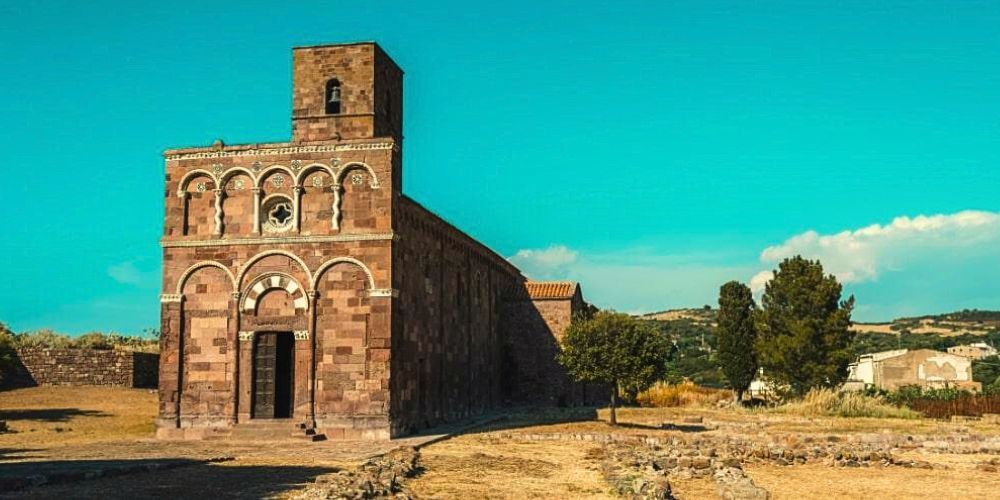
Our journey across the hinterland of North Sardinia will touch upon 10 stops equally divided between castles and churches, places immersed in nature often difficult to reach by public transport.
To be able to move around easily, we advise you to choose between a car or a motorbike. The conformation of Sardinian roads can indeed be pretty stimulating for two-wheel enthusiasts.
As your wheels caress the island's winding roads, you will find yourself immersed in beautiful landscapes that constantly change. You will soon realise that the Sardinian landscape is the first wonder to discover: a masterpiece of nature amidst bright and intense colours, the Mediterranean scents and the hissing of winds.
Thus begins our double itinerary discovering the things to see in Sardinia beyond beaches and sea, traveling between five castles and five churches that made the history of this wonderful island.
Things to see in Sardinia without beaches: medieval castles and forts
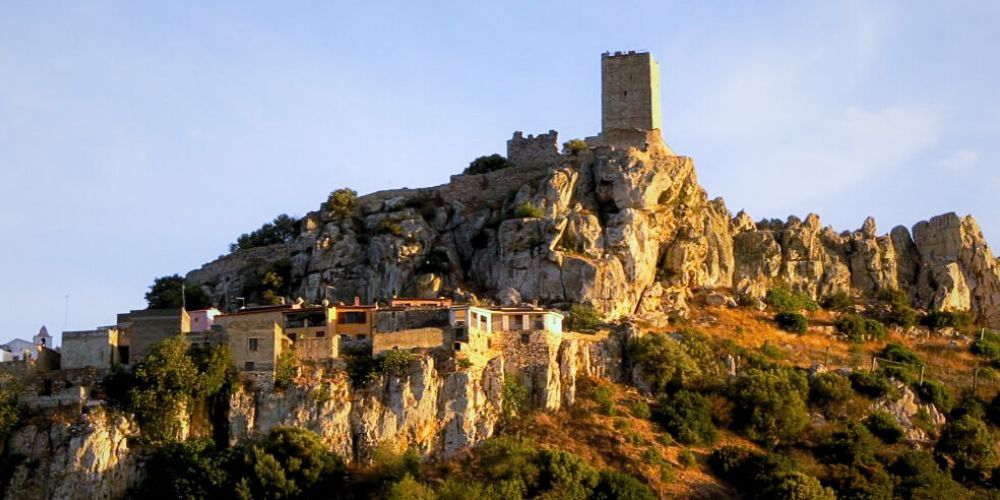
Sardinian castles are fascinating testimonies of the island's Middle Ages, when Sardinia was divided into four Giudicati, the administrative divisions in use in the island: they're the kingdoms of Cagliari, Arborea, Torres and Gallura. They were independent and "democratic" state entities, each one ruled by a king or judge.
There were around 100 manors scattered around the island, erected between the 11th and 14th centuries, many of them have come down to us almost intact, while some others appear as silent ruins in the rugged Sardinian landscape. Each one, anyway, carries a charming history mixed with legends from the popular imagination.
Here are the most beautiful castles in the north of the island. For further information about the roads to drive on, the length and the duration of the journey, check out the map of the castles itinerary in the sardinian inland.
The stops:
· Castello di Pedres, Olbia
· Palazzo di Baldu, Luogosanto
· Castello di Casteldoria, Santa Maria Coghinas
· Castello dei Doria, Chiaramonti
· Castello di Burgos, Burgos
First stop: Castello di Pedres, Olbia
Our travel itinerary across the sardinian castles begins a few kilometres away from the city of Olbia. Here lies a proud representative of medieval Sardinia: the Castle of Pedres. From the top of a hill around 100 metres high, the fortress protected the surrounding plain from incursions from the south.
Today it appears as a square tower with a polygonal wall around it. Near the manor is a significant site for Sardinian archaeology: the Tomb of the Giants of Su mont'e s'Abe. The site, whose shape evokes a bull's head, is a 4,000-year-old burial site belonging to the Nuragics, the ancient Sardinian people.
Second stop: Palazzo di Baldu, Luogosanto
The journey continues towards Luogosanto to discover Palazzo di Baldu, a jewel of medieval Sardinian architecture (at least from 1300, perhaps even earlier) that stands majestically in the heart of Gallura. This ancient fortress, immersed in a thick forest of holm oaks, was the very core of the ancient settlement of Villa de Sent Steva, or Santo Stefano.
Characterized by a quadrangular tower and many chambers arranged around its large courtyard, the palace represented the administrative, social and cultural heart of this community. Although its status of ruin, today Palazzo di Baldu continues to intrigue and enchant visitors with its history and its evocative location, offering an authentic glimpse of Sardinia from the era of kings and knights.
To complete the visit to this site don't miss the little church of Santo Stefano, not far from the palace and the rest of the ancient village, a truly picturesque place surrounded by greenery where is kept a marble statue of the saint.
Third stop: Castello di Casteldoria, Santa Maria Coghinas
Going on our itinerary throught the inland castels we head to the historical region of Anglona, a stone's throw from Santa Maria Coghinas. Here, the tower of a mysterious fortress peers down from above over the waters of a lake. It is the manor of Casteldoria that the Genoese Doria family had built around the 12th century to guard its properties.
Today, apart from the pentagonal tower 20 metres high, what remains of the building are some sections of the walls, the remains of the chapel and a large cistern to store waters.
The greatest fascination of this castle lies in the legends that even the famous Sardinian writer Grazia Deledda mentioned in one of her works. It tells of a network of underground tunnels allegedly serving the Doria family as a secret passage. Here, behind a heavy iron door, the family treasure seems to have been kept.
Fourth stop: Castello dei Doria, Chiaramonti
Going on with the exploration of the countryside of Anglona, in the northwest of the island, lies a small village called Chiaramonti. Above the village are the ruins of the Doria Castle, another fortress the Ligurian family built to defend their possessions in Northern Sardinia.
The castle was erected between the 12th and 13th centuries and later became a church. Today, we see the outline of the tower of the fortress, a single-nave building with eight chapels on either side and what probably was the bell tower: the remains of the place of worship.
You can admire a fantastic view of the entire Anglona valley from the ruins, immersed in silence. From time to time, this picturesque setting becomes the scene of some of the most beautiful concerts and events in northern Sardinia, such as those that are part of the cultural program by Sassari Chamber of Commerce.
Fifth stop: Castello di Burgos, Burgos
The hinterland tour discovering the mysterious and picturesque sardinian castles takes us eventually to the Castle of Burgos, or Castle of Goceano, that is the richest in terms of historical memories and legends in Northern Sardinia.
Perched on a rock 650 metres above sea level, it dominates the village below, like a solitary and impregnable witness of Sardinia's medieval past. It was built around 1134 at the behest of Gonario I of Torres. It has triple walls and a 16-metre-high main tower.
In their long life, these walls were the scene of battles and scabrous events involving queens, illustrious personalities of the time and bandits.
Today a few spirits seem to haunt the ruins. The ghost of Judge William of Cagliari, invoking the queen's forgiveness, and the one of Adelasia, the last woman-Judge of Torres.
Along with the manor house, the Castle Museum in the centre of Burgos is also worth a visit.
Things to see in Sardinia without beaches: romanesque churches
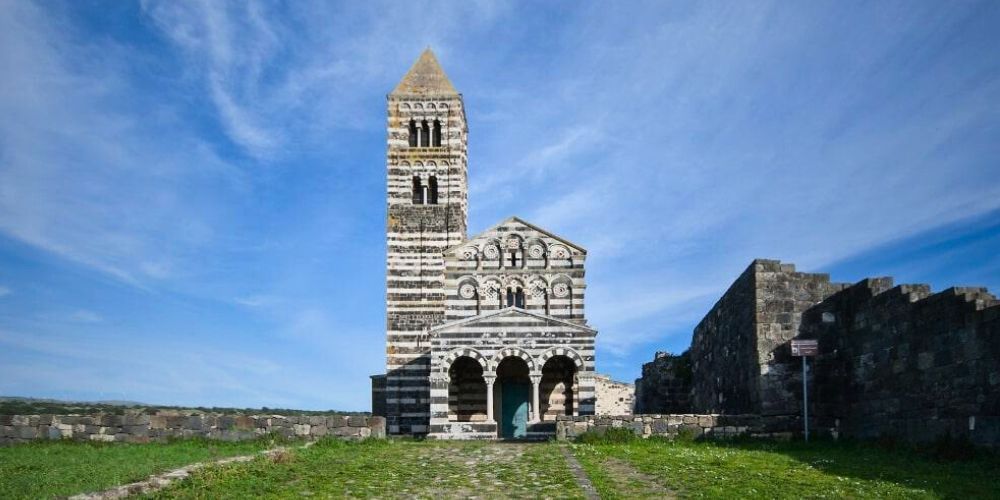
We have completed our itinerary to discover the profane side of the Sardinian Middle Ages. It is time to get to know the gems of sacred art on the island dating from the same period: the Romanesque churches. Here are three of the fascinating ones in the Northern hinterland.
These places have preserved the purity and beauty of faith for centuries, finding in the union with the bucolic landscape of the Sardinian hinterland the perfect combination of earthly serenity and spiritual holiness.
Here are the most beautiful churches in the north of the island. For further information about the roads to drive on, the length and the duration of the journey, check out the map of the churches itinerary in the sardinian inland.
The stops:
· SS. Trinità di Saccargia, Codrongianos
· Nostra Signora del Regno, Ardara
· Santa Maria de Mesu Mundu, Anela
· Nostra Signora di Castro, Oschiri
· Nostra Signora di Tergu, Tergu
First stop: SS. Trinità di Saccargia, Codrongianos
Let's start with the most spectacular and famous Romanesque church in Sardinia: the basilica della Santissima Trinità di Saccargia (Basilica of the Holy Trinity of Saccargia), in the territory of Codrongianos in the province of Sassari.
It pops up suddenly in the middle of a valley in the countryside of North Sardinia. It is perfect in its chiaroscuro colour scheme, with the bell tower soaring high into the sky and alongside the ruins of the monastery and cloister of the Camaldolese monks.
The birth of Saccargia is also intertwined with the history of the Giudicati of Sardinia. It seems that Constantine I of Torres ordered its construction. The judge, desirous of an heir, had an apparition that induced him to have the church erected. The basilica was consecrated in 1116, but the land on which it stands is no ordinary place: ancestral cults have always been practised here.
By looking closely at the porch of the façade, we can notice a curious detail: the frame of the left pillar depicts crouching cattle. Indeed there's a legend believed to be the origin of the abbey's name. It tells of 's'acca argia', 'the dappled cow' that knelt on its back here every day as a sign of prayer.
Second stop: Nostra Signora del Regno, Ardara
Let's move on in our itinerary with the church where the judges of Torres took their oath and where they were buried. Nearby, the ruins of the royal palace.
Near the village of Ardara, in the region of Logudoro, here's the cathedral of Nostra Signora del Regno (Our Lady of the Kingdom) appears as a dark stain on the slopes of Montesanto.
At first sight, what immediately impacts is its majestic grandeur, then the contrast between the black of the trachyte and the gold of the 16th-century altarpiece behind the altar.
Third stop: Santa Maria de Mesu Mundu, Anela
For the next stop on the itinerary we move to the purest hinterland of the province of Sassari, in the mountain-side territory known as Goceano. Our destination is the Church of Santa Maria di Mesu Mundu, also known as Santa Maria of Half World’s or simply the Church of Madonna delle Rose, near the small village of Anela.
This particular religious building has very peculiar characteristics, such as its architectural and aesthetic style of transition between Romanesque and Gothic (its original construction was completed in 1162, the year of its consecration) based on the development of simple yet elegant shapes, and its geographical position that sees it as the protagonist of one of the most genuine Sardinian bucolic landscapes there is.
In addition to this the perfect conservation of the building over the centuries, thanks above all to the care of the communities of monks who have lived here and to the peace that has always stood in this portion of the island.
Today Santa Maria de Mesu Mundu houses beautiful colored wooden statues dating back to the 16th and 17th centuries, in particular those of Saint Francis and Holy Mary.
Fourth stop: Nostra Signora di Castro, Oschiri
The next stop takes us near Lake Coghinas, precisely in the territory of the municipality of Oschiri, to discover together the beauty and the stunning landscapes of the Church of Nostra Signora di Castro, one of the most significant examples of Romanesque architecture in Sardinia.
The construction of the building began shortly after the year 1000, with historical sources that prove its existence already at the beginning of 1100 and officially consecrated in 1174, rising majestically on a hill that dominates a rural landscape of great charm not far from Mount Limbara, at the time the seat of the ancient diocese of Castro.
Nostra Signora di Castro stands out for the sobriety of its aesthetics from a material point of view (the church is made of trachyte) and for the harmony of its architectural lines, with a facade embellished with geometric decorations. The interior, more austere than the exterior but no less rich in spirituality, houses a wonderful late-Baroque wooden retablo, dating back to the end of the 17th century and the beginning of the 18th century.
The church of Nostra Signora di Castro is closely related to the religious and popular tradition of Oschiri, especially on the occasion of the feast dedicated to the Virgin, celebrated on the Sunday after Easter with processions, songs and traditional dances.
Fifth stop: Nostra Signora di Tergu, Tergu
This adventurous itinerary across the most interesting churches and sacred places in North Sardinia's hinterland ends at the church of Nostra Signora di Tergu (Our Lady of Tergu), another architectural jewel. It stands majestically on a plateau in the Anglona region and has a history stretching back almost a thousand years. Probably built between 1065 and 1082, it is a masterpiece of Romanesque-Pisan architecture embellished with Gothic and Baroque forms.
It's characterized by a polychromy made of red-violet trachyte stone, white limestone and reddish vulcanite. Next to the church are the ruins of the monastery.
One of the most important religious traditions of the whole of Sardinia is linked to this sacred building. Nostra Signora di Tergu is the destination of the Lunissanti procession. This rite marks the beginning of Holy Week for the inhabitants of Castelsardo, a village overlooking the seaside only 11 kilometres north of the Romanesque basilica.
Things to see in Sardinia in the hinterland: a trip beyond the sea
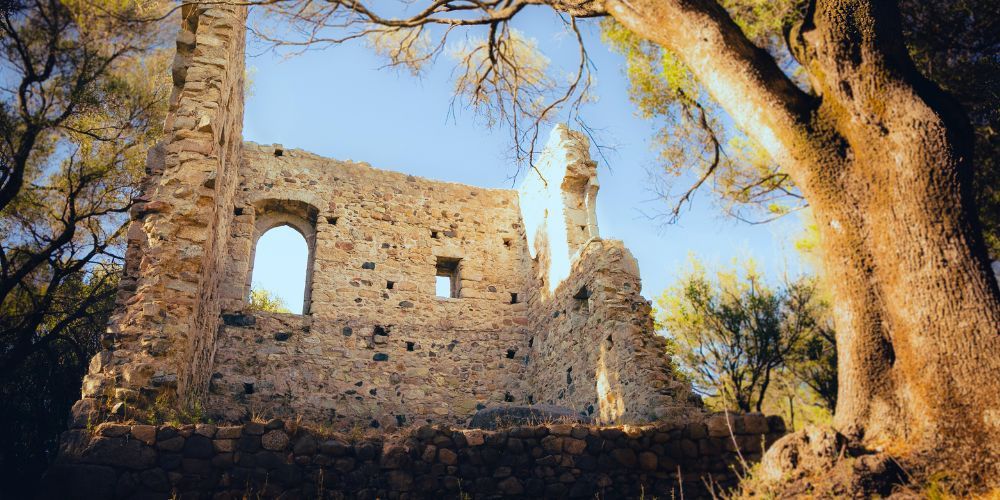
A journey through the history of Sardinia has the flavor of infinity, a unique sensation that can be felt just by experiencing it far from the beaches and the seaside, simply by discovering its extraordinary hinterland.
Indeed, to speak only of 'history' here is reductive, because in this magical land, also made of castles and churches from the last millennium, myths, stories and legends merge into a great plot: here is the true charm of an island with so much to tell, even out of the season, even and especially by its most authentic side.
About the author
Written on 22/11/2023

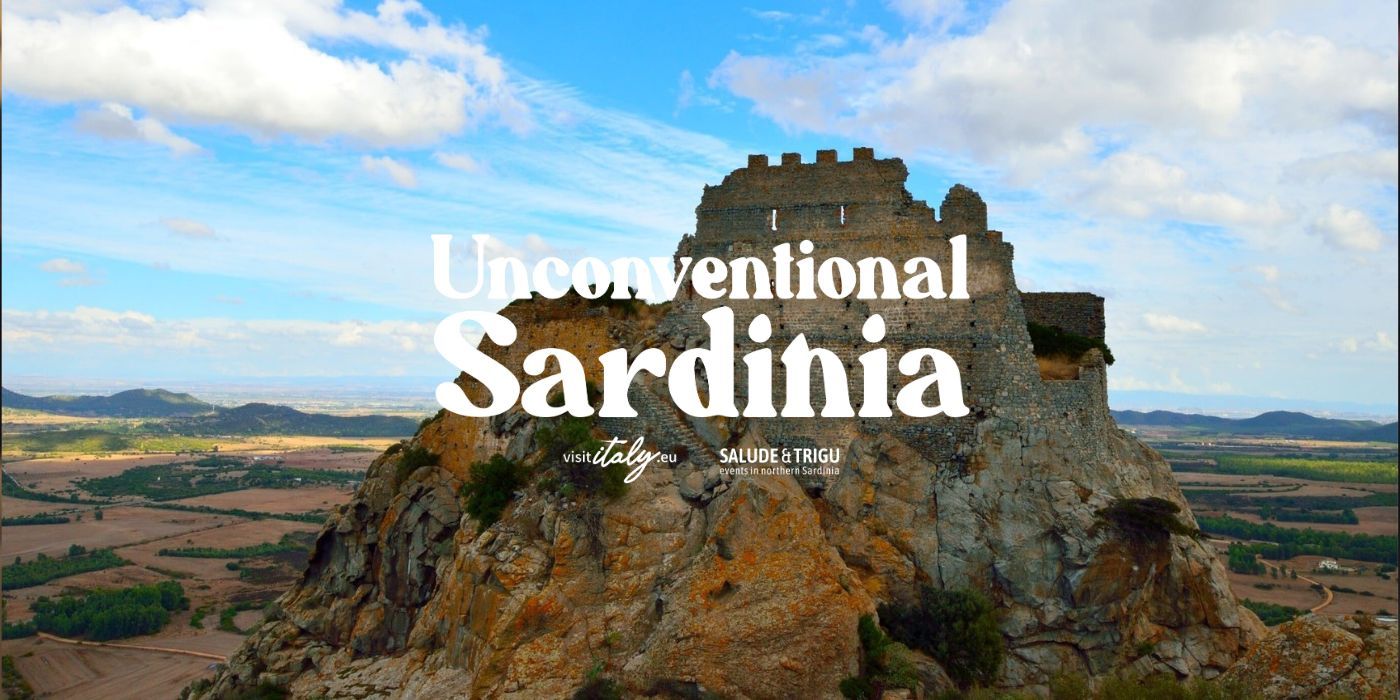

Chiara Musino
Things to see in Sardinia without beaches: castles, churches and other wonders in an double itinerary in 10 stops for discovering its hinterland.